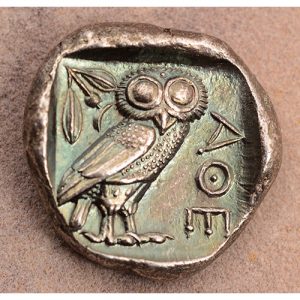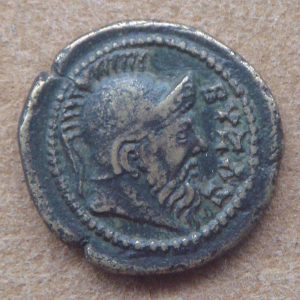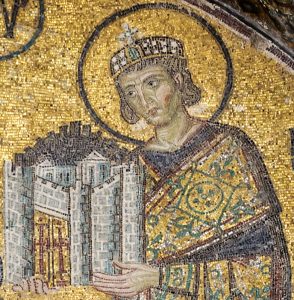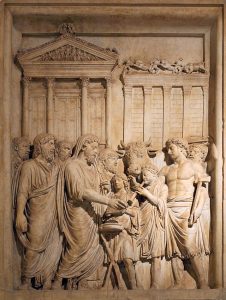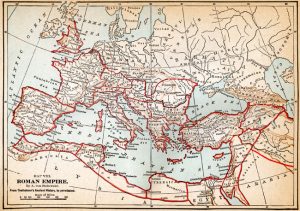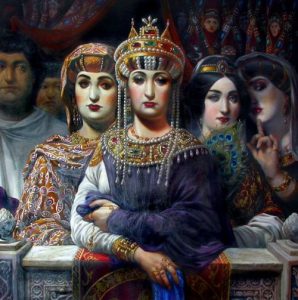e) During the 7th century BC the unassimilated Greek Latins of Alba Longa argued that the Greek Latins of Rome were no longer pure Greeks due to the fact that they intermixed with barbarians and other slaves and dependants in that region.
32. About 500 BC, there were “about fifty” Roman gentes, many of which had a population numbered in the thousands. A Patrician member of the senate lead each one of these gentes. All members of the gentes learned and embraced their laws ( νόμοι ) and rules ( προστάγματα ) of conduct from childhood; these laws and rules were kept in sacred books, away from prying eyes.[22] Their slaves and dependants spoke a form of Italian that developed into a Latin dialect mingled with Greek. It was these non Greek speaking dependants of Rome who finally forced the Romans to record these laws in written form.
33. The Romans produced a text of laws in proto-Latin in about 450 BC as a result of violent protests of these dependants and slaves, for these slaves and other dependants were not aware of the laws according to which they were being judged and ultimately punished by Roman magistrates. Faced with these revolts, the Roman Senate sent a delegation to Athens to explore all possibilities. The denouement was met in a set of 10 texts on bronze tables that finally became the “The Code of Twelve Tables.” Table 11 forbade the marriage between members of the gentes and the rest of the population of Rome, in other words, between those of Greek origin, and barbarians.
34. The determinant factor was that, for centuries, the Greek colonies were being slowly absorbed by barbarians among whom they lived. The Greeks’ idea was that the gentes had to remain pure and unsullied, for the sake of their Gods, in order to become aware of the sacrifices of their priests, as the boding be heeded, in pursuance of the Gods to acquiesce their decisions on legal, social and especially military matters.
35. In 445 BC, the tribune of the Plebeians, Gaius Canuleius, proposed a bill concerning the intermarriage of patricians and plebeians. The patricians did not like mixing their blood and subverting their principles inhered through the gentes and their families. The tribunes cautiously proposed that it should be lawful for some of the consuls to be elected by the plebs. Later, as many as nine tribunes proposed a new bill giving the people the possibility to elect consuls either from the plebs or the patricians. “Gaius Canuleius had a great plan! He was aiming at adulterating the gentes and undermining both public and private life strata. Confusion would ensue as origins and social distinctions are expunged. No man would be able to recognise neither himself nor his kindred. The gentes adjured: what was the object of promiscuous marriages, if not that plebeians and patricians might mingle together almost like beasts?”[23]
36. The “Decemviri Legibus Scribundis Consulari Imperio” had forbidden the intermarriage of Patricians and Plebeians; the simple reason was, they thought, that the Plebeians had neither the auspices of the Gods, as interpreted by Tiresias, the seer of Thebes, nor were they born of the first gentes. At this, the plebeians blazed with indignation and revolts. Hence the Conflict of the Orders between the Patricians, descendants of the original Greek gentes, and the Plebeians, of indefinite ancestry. [24]
39. According to Roman tradition, Rome was founded by the Latin twins: Romulus and Romos. Tullus Hostilius (672-640 BC), the King of Rome, made overtures to the King of Alba Longa, Mettius Fufetius[25], to unite the Latin and Roman peoples in order to cement stronger defense and ties in every other respect. They did not agree on who should become the leader. Mettius argued that “it is a fact that the Albanian race was unadulterated since the founding of the city, and one cannot point to any race of mankind , except the Greeks and Latins, to whom we have granted citizenship; whereas you have corrupted the purity of your body politic by admitting Tyrrhenians, Sabines,[ 26 ] and others in great numbers, so that the true-born element among you is a tiny fraction, in comparison with those of alien race. And if we should yield the command to you, the base-born will rule over the true-born, barbarians over Greeks, and immigrants over the native-born.”[27]
40. Livy, who wrote in Latin, reports this controversy as a quarrel between two Greek-speaking Latin States of the very same Trojan race. Subsequent to an interregnum, after Romulus and Numa Pompilius, the third king of Rome was Tullus Hostilius. “This monarch, writes Livy, was not only unlike the last, but was actually more warlike than Romulus had ever been.” Tullus manipulated circumstances in such a way that he trapped the Albanian envoys into admitting that they had instructions to declare war should restitution be denied to them. To this Tullus replied: ‘Tell your king that the Roman sovereign calls the Gods to witness that they may invoke malediction and all the disasters of this war on the guilty nation.’ With this answer the Albanians returned to their city, and both sides prepared for civil war, as if fathers were arrayed against sons; for both were of Trojan ancestry, since Lavinium [28] had arrived from Troy, Alba from Lavinium, and the Romans from the line of the Albanian kings. Still, no battle was fought, and when only the buildings of one of the cities had been destroyed, the two peoples merged into one.”[29] The differences between the Greek-speaking-Latin Albanians and the Greek-speaking Latin Romans had been finally settled not by war, but by a contest between Albanian triplet brothers on the one side, and Roman triplet brothers on the other side.[30] The Romans won, and so demolished the buildings of the Latin Capital of Alba Longa and transported the whole population of Albanian Latins to Rome and thus reunited both Latin peoples, once more, into one nation. The six patricians of the six gentes [31] of Alba Longa were added to the Roman Senate. The most famous member of the Albanian gens of the Julii was Julius Caesar. So whether the falsifiers of Roman history like it or not, Julius Caesar belonged to a Greek-Trojan-Latin gens/γένος.
41. Read the indexes at the end of the original texts of Roman history of Livy and Dionysius of Halicarnassos, both of whom give us a continuous narrative, where such names as Latins, Romans and Sabines abound, and you shall be able to trace true historical reality. Since 1954 however, in sharp contrast to original historical sources, we have writings of contemporary ‘specialists’ who deliberately circumvent, if not falsify original Greek and Roman sources, claiming that archaeology must be given prevalence over surviving written sources.
42. One of the best examples of such a crooked and ideological method is to put such names as “Latium, Latins” side by side, in the index and proceed, with the assumption that we have a geographical area the original inhabitants of which remain unknown. The use of archaeology is thus necessary, they pretend, in an attempt to uncover the layers of peoples who inhabited the area. And so, Latium becomes an area of archaeological study, as though one is not sure who lived in this area during antiquity. “The Cambridge Ancient History, Volume VII. The Hellenistic Monarchies and the Rise of Rome” (published in 1954, pages 312 to 857) is an example of the use of such an ideological method. On page 956, “Latium, Latins” begins with “Aeneas…”; one tends to assume that the actual title is “Aeneas and Latium, Latins” So one turns to page 363, chapter XI, VI : The Foundation Legends” where Hugh Last of Oxford concludes that “the legends which grew up round the origin of Rome have so slight a value as evidence for the history of the city that they can claim little space: all that is needed is to make their irrelevance plain.” The question is whether the honourable writer is researching the sources and evaluating them, or distorting them in order to fit into the realm of 18th century British, French, German and, not in the least, Russian ideologies to make History fit their political plans to reorganise the maps of Europe and the Middle East, and give ideological variety to Father Charlemagne’s charlatanism of 794.
43. Roman historians, however, narrate a completely different History. Dionysius summarizes the reports of the Greek origin of the Romans, quoting Romans, as follows: “But the most learned of the Roman historians, among whom is Porcius Cato (who compiled, with the greatest care, the ‘origins’ of Italian cities) Gaius Sempronius and a great many others, say that they are Greeks, part of those who once dwelt in Achaia [ 32 ], and that they migrated many generations before the Trojan war.”[ 33 ] Livy asserts the same when he denotes the controversy between the Albanians and Romans that led to the destruction of Alba Longa, which in turn, led to the assimilation of the Albanian Latins in the Roman Nation. Everything else is ideological deception.
44. Ultimately, all Greek-speaking Latins and Greek-speaking Sabines joined the Roman Nation that was divided into Patrician gentes, and tribes of non-Greek origin, led by Tribunes, with the Latin language having merely become the scriptural medium of Roman legislation. Romans at large still spoke and were educated in Greek and not Latin. Latin was never spoken by any people at any time in history, whereas Greek is still spoken by some twenty million people today!
45. Starting in the 7th century and up to the 5th century BC, “…the plebes were being stirred up again by their tribunes, who postulated that the best political institutions for free men is freedom of speech (ισηγορία). They demanded all affairs, both private and public, be carried out according to voted laws. For, there did not exist, as of yet, among the Romans, an equality of rights, nor were there written principles of Justice.” This led to the adoption of the Code of the Twelve Tables. The Consuls of the Patricians and the Tribunes of the Plebs deliberated mainly in Latin, with Greek being used when the speaker spoke no Latin, as the Greek language was the common language of culture, education and daily intercourse of the gentes. This was the case up to the Frankish papacy of 1046, and the Norman conquest of Britain in 1066. Even today : when one wants to prove deep culture and sound education, learning and mastering Greek is the fundamental constituent of the entreprise.
46. As we have already noted, the population of France in 1789 included 2% nobility, 13% franchised middle class and 85% villains and serfs.[ 34 ] The latter 85% were enclosed within slave camps and guarded from escape by some 40,000 castles. These serfs and villains had been isolated from each other for so many centuries that they ended up speaking their own local patois of which some 35 are recorded and still spoken locally. This reality forced 85% of the population to learn and adopt the language of their former oppressors. There had to have been a very serious reason why the Frankish military kept so much of the population isolated from each other. It seems that the best explanation of this military phenomenon of the Franks until 1789 is to be found in the Pseudo-Isidorean Decretals of 850.[ 35 ] These forged documents supported a Church structure that put the Frankish bishops directly under the control of the Pope of Rome and his curia, both of which were still Roman nationals, and therefore under the rule of the Roman Empire and its Roman Emperor in Constantinople New Rome. At the time the Franks accepted these Decretals as genuine and argued that they were valid locally only within the Roman Empire, a difficult argument to maintain when a small number of Franks were ruling over a far superior number of Romans. Soon enough, the Franks made their final decision to act decisively. The result was their final takeover of the Papacy by enthroning, from 1012 to 1046, their own lackeys. They consequently and permanently got rid of Roman Popes and their curia and controlled the Pope of Rome and his curia.
47. While the Norman Franks were in process of expelling the Roman army from Southern Italy and of helping the Italo-Franks wrest the Papacy from the Franconian emperors, their Duke William of Normandy invaded England with Pope Alexander’s blessing in 1066. He had his Lombard friend, the “Blessed Saint” Lanfranc, the pope’s teacher, installed as the first non-Roman /Saxon Archbishop of Canterbury in 1070, and together they replaced all native bishops with Franks. All Celtic and Saxon bishops and abbots were dismissed en masse[ 36 ] and sentenced to prison to die premature deaths by torture and starvation.[ 37 ] The new noblemen bishops from the Frankish Empire were in turn killed by the people whenever opportunity presented itself.[ 38 ] Indeed the Saxons and Celts celebrated the death of Lanfranc in 1089 by launching their third and most severe revolt against the Teutonic intruders.[ 39 ] The most famous of the Saxon revolutionary leaders against the Normans was Robin Hood. He had become ill and was taken by Little John to a nunnery where someone recognised him. The Norman nun who was curing him by bloodletting converted this cure into an assassination by letting him bleed to death. Little John and his men escaped to Ireland to continue their war against the Normans.[ 40 ] That Robin Hood and his men were fighting against bad King John in favour of good King Richard is an interesting and clever fable indeed. In any case, Norman reforms through military might turned into ‘crusades’ in both East and West. They ultimately provoked the Protestant Reformation and met with little success among the East Romans.
48. This tradition of murderous bishops, clergy and monks found their ‘theologian’ in Saint Bernard of Clairvaux. In his “De Laude novae militiae ad milites Templi” [ 41 ] he argues that the Knight Templars “that kill for religion, commit no evil, but rather do good for their people and themselves. If they die in battle, they gain heaven; if they kill their enemies, they avenge Christ. Either way, God is pleased.” [ 42 ] The Inquisition represented the highest ‘theological’ form of Frankish criminality. Tens of thousands were condemned and put to death for the satisfaction and in the name of God, or so the Teutonic Franks – depraved Popes, intemperate bishops, greedy princes and rapacious kings – preached. Ideologically, this all culminated with the jocund “Contra errores Graecorum, ad Urbanum IV Pontificem Maximum” of 1263 ( just a few years upon the sack of Constantinople and New Rome by the crusaders who, as a token of their tradition and Belief, defecated on the Holy Table of the Church of the Holy Wisdom of God [ Αγία τοῦ Θεοῦ Σοφία ] before running off to Venice, Old Rome and elsewhere in Frankia with anything they can carry ) by – yet another – ‘Saint’ Thomas Aquinas, during which time, the substantive : ‘Greek’ started its semantic vocation as : ‘cheater, trickster and deceiver’, and that of ‘Roman’ started its new semantic parthenogenesis as utterly and completely separate from its Greek origins and reality, in order to establish the new ideological and religious powers of dictatorial and depraved Popes and kings.
[ 22 ] Diosysius, RA X.I-IV. Livy, AUC III. IX-XI. 459 B.C.
[ 23 ] Livy, Ibid, IV, 1ff.
[ 24 ] Livy, Ibid, IV, vi.1-3
[ 25 ] The quoted source used by Livy calls both leaders kings. I, XXII
[ 26 ] A Greek race but not a pure one.
[ 27 ] In the year 459BC Dionysius of Halicarnassus’ Roman Antiquities, X.2-5. Livy, AUC, III, ix-x, 5
[ 28 ] The first town built by the Trojan refugees under Aeneas with permission from Latinus, King of the Arcadian Aborigines. Livy, AUC, I.i.1-6.
[ 29 ] Livy, AUC, I, xxiii, 1-2.
[ 30 ] Livy, AUC, I, xxiv ff.
[ 31 ] Livy, AUC, I, xxx, 2. Julii, Servilii, Quinctii, Geganii, Curiatii, and Cloelii. Dionysius, RA, III, xxix,7. Ιου�”ίους, Σερουι�”ίους, Κορατίους, Κοιντι�”ίους, Κ�”οι�”ίους and �”ερανίους.
[ 32 ] Greece.
[ 33 ] Dionysius, RA, I, xi, 1ff.
[ 34 ] See footnote [ 9 ].
[ 35 ] John S. Romanides, “Franks, Romans, Feudalism and Doctrine, an interplay between Theology and Society, Holy Cross Orthodox Press, 1981, pp.20-32.
[ 36 ] For documented sources of the details of the murder of the Celtic and Saxon Bishops and abbots and their replacement by nobles from the Frankish realms of Francia, i.e. Gallia, Germania and Italia see Auguste Thierry, Histoire de la Conquête de l’ Angleterre par les Normands, Paris 1843, vol. 2, pp. 147 (1071-1072), 215-219 (1075-1076), 284, 313-314, 318 (1087-1094); vol. 3, pp. 35 (1110-1138), 214-215 (1203 ).
[ 37 ] Ibid. voI. 2, pp. 55;’ 66 (1068 ) 111,145,184 (1070-1072 ), 215 (1075-1076), 240-242 (1082), 313-316 (1088-1089); vol. 3, pp. 35, 44, 47 (1110-1140).
[ 38 ] Ibid.; vol. 2, pp. 232, 236 (1080); vol. 3; pp. 27, 36-37; 39 (1110-1138), 55 (1141-1142); vol. 4, p. 349 (1387).
[ 39 ] Ibid., vol, 2, p. 315. Robin Hood led a phase of this revolution until he was recognized by Norman nuns who let him bleed to death while curing him by bloodletting.
[ 40 ] 1189-1194. Accuse des ballades qui nous ont été conservées ne raconte la mort de Robin Hood; la tradition vulgaire est qu’il périt dans un convent de femmes; où un jour, se sentant malade, il était allé demander des secours. On devait lui tirer du sang, et la nonne qui savait faire cette opération, ayant reconnu Robin Hood, la pratiqua sur lui de manière � le tuer. (Percy’s Reliquides of ancient english poetry, vol. I, p.198, 6e cdd.)
Ce récit, qu’on ne peut ni affirmer ni contester, est assez conforme aux moeurs du XIIe siècle; beaucoup de femmes dans les riches monastères, s’ occupaient alors � étudier la médicine, et � composer des remèdes qu’elles offraient gratuitement aux pauvres. De plus, en Angleterre, depuis la conquête, les supérieures des abbayes et la plus grande partie des religieuses étaient d’ extraction normande, ainsi que le prouvent leurs statuts, rédigés en vieux francais (Regula monialium Beatae Mariae de Sopwell, in auctuario, additamentor, ad Matth. Paris, t I,p. 261) : cette circonstance explique peut-être comment le chef des bandits saxons, que les ordonnances royals avait mis hors la loi, trouva des ennemis dans le couvent où il était allé chercher assistance. Après sa mort, la troupe dont il était le chef et l’âme se dispersa; et Petit-Jean, son fidèle compagnon, désespérant de se maintenir en Angleterre, et poussé par l’envie de continuer la guerre contre les Normands, se rendit en Irlande, où il prit part aux révoltes des indigènes Ainsi fut dissoute la dernière troupe de brigands anglais qui ait eu un objet et un caractère politique, et qui mèrite par l� une mention dans l’histoire.
[ 41 ] Migne, P. L.182, .921-940.
[ 42 ] As summarized in The History of Feudalism, edited by David Herlihy, 1970, p. 282-283.
[ 43 ] The text is as follows: “Toujours entendu que, seront considérés dès-� -présent commes Hellènes, et prendront rang dans la catégorie de ceux qui profiteront du droit d’émigration:-1)Tous les Grecs natifs du Territoire Ottoman, qui ont émigré avant le 16 Juin, 1830, et qui ne sont pas retourné en Turqie pour s’y établir: 2) Les Grecs � qui le droit d’émigration a été accordé par le Protocole du 16 Juin, 1830, et qui ont émigré entre la date du dit Protocole et le 9 Decembre, 1835, jour où la Carte de la frontierè a été remise � la Porte; pourvu toujours qu’ils aient rempli les conditions requises � cet égard par le présent Acte.” State Papers 1836-1837, The Foreign Office, vol. 25, p. 792.
[ 44 ] C. M. Woodhouse, “Modern Greece, A Short History,” Faber and Faber, p. 122.
[ 45 ] See footnote [ 9 ].
[ 46 ] As far a we know from dialogue with Jews the cure in question was part of Old Testament Hassidic tradition and evidently is still so.

